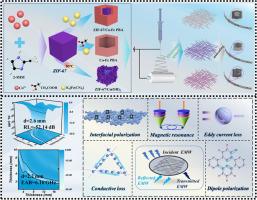“Two birds one stone” strategy to integrate electromagnetic wave absorption and self-anticorrosion in magnetic nanocomposites with double-shell hollow structure
IF 11.2
1区 材料科学
Q1 MATERIALS SCIENCE, MULTIDISCIPLINARY
引用次数: 0
Abstract
Magnetic metal has broad application prospects in the field of electromagnetic wave (EMW) absorption due to its excellent dielectric and magnetic properties. However, high density and poor chemical stability constrain their development potential. The combination of magnetic metals with other lightweight carbon materials is an effective solution. In this work, magnetic nanoparticle fiber composites were prepared by electrostatic spinning and high-temperature annealing processes. By adjusting the preparation process and annealing temperature, Co/Co7Fe3/CF-800 fiber composites containing double-shell hollow structured nanocubes were cleverly synthesized. The material is mixed with paraffin wax and has a minimum reflection loss (RL) of –52.14 dB and a maximum effective absorption bandwidth (EAB) of 6.16 GHz at a load of 10 wt%. By analyzing the electromagnetic parameters of the material, it was demonstrated that the material absorbs EMW through the synergistic effect of dielectric and magnetic losses. Electrochemical testing in a simulated seawater environment demonstrated that the material also has a degree of self-anticorrosion capability. This work provides new strategies for designing materials with excellent electromagnetic wave absorption and self-anticorrosion properties.

双壳中空结构磁性纳米复合材料的电磁波吸收与自抗蚀一体化 "一石二鸟 "策略
磁性金属具有优异的介电性能和磁性能,在电磁波吸收领域具有广阔的应用前景。然而,高密度和较差的化学稳定性限制了其发展潜力。将磁性金属与其他轻质碳材料相结合是一种有效的解决方案。本研究采用静电纺丝和高温退火工艺制备了磁性纳米粒子纤维复合材料。通过调整制备工艺和退火温度,巧妙地合成了含有双壳中空结构纳米立方体的 Co/Co7Fe3/CF-800 纤维复合材料。该材料与石蜡混合,在负载为 10 wt% 时,最小反射损耗 (RL) 为 -52.14 dB,最大有效吸收带宽 (EAB) 为 6.16 GHz。通过分析该材料的电磁参数,证明该材料通过介电损耗和磁损耗的协同效应吸收电磁波。在模拟海水环境中进行的电化学测试表明,该材料还具有一定程度的自抗蚀能力。这项工作为设计具有优异电磁波吸收和自抗腐蚀性能的材料提供了新的策略。
本文章由计算机程序翻译,如有差异,请以英文原文为准。
求助全文
约1分钟内获得全文
求助全文
来源期刊

Journal of Materials Science & Technology
工程技术-材料科学:综合
CiteScore
20.00
自引率
11.00%
发文量
995
审稿时长
13 days
期刊介绍:
Journal of Materials Science & Technology strives to promote global collaboration in the field of materials science and technology. It primarily publishes original research papers, invited review articles, letters, research notes, and summaries of scientific achievements. The journal covers a wide range of materials science and technology topics, including metallic materials, inorganic nonmetallic materials, and composite materials.
 求助内容:
求助内容: 应助结果提醒方式:
应助结果提醒方式:


